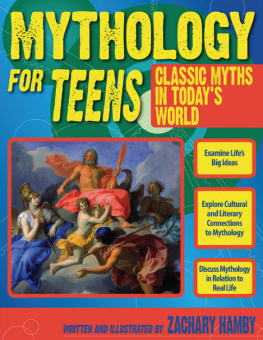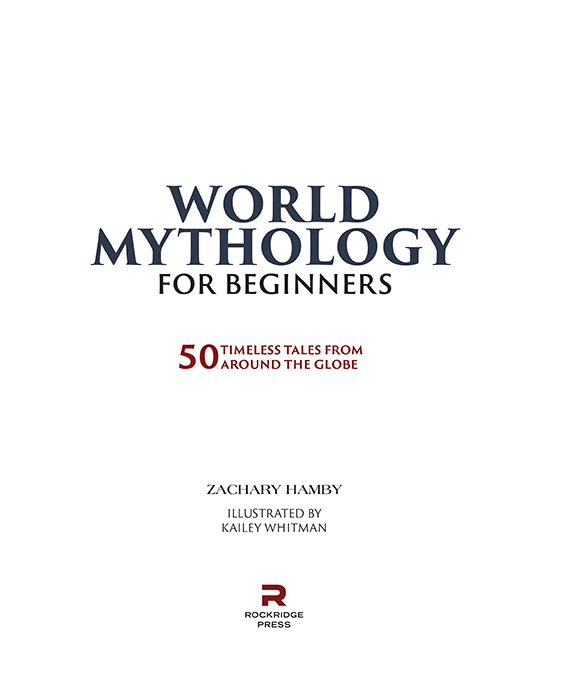Copyright 2021 by Rockridge Press, Emeryville, California
No part of this publication may be reproduced, stored in a retrieval system, or transmitted in any form or by any means, electronic, mechanical, photocopying, recording, scanning, or otherwise, except as permitted under Sections 107 or 108 of the 1976 United States Copyright Act, without the prior written permission of the Publisher. Requests to the Publisher for permission should be addressed to the Permissions Department, Rockridge Press, 6005 Shellmound Street, Suite 175, Emeryville, CA 94608.
Limit of Liability/Disclaimer of Warranty: The Publisher and the author make no representations or warranties with respect to the accuracy or completeness of the contents of this work and specifically disclaim all warranties, including without limitation warranties of fitness for a particular purpose. No warranty may be created or extended by sales or promotional materials. The advice and strategies contained herein may not be suitable for every situation. This work is sold with the understanding that the Publisher is not engaged in rendering medical, legal, or other professional advice or services. If professional assistance is required, the services of a competent professional person should be sought. Neither the Publisher nor the author shall be liable for damages arising herefrom. The fact that an individual, organization, or website is referred to in this work as a citation and/or potential source of further information does not mean that the author or the Publisher endorses the information the individual, organization, or website may provide or recommendations they/it may make. Further, readers should be aware that websites listed in this work may have changed or disappeared between when this work was written and when it is read.
For general information on our other products and services or to obtain technical support, please contact our Customer Care Department within the United States at (866) 744-2665, or outside the United States at (510) 253-0500.
Rockridge Press publishes its books in a variety of electronic and print formats. Some content that appears in print may not be available in electronic books, and vice versa.
TRADEMARKS: Rockridge Press and the Rockridge Press logo are trademarks or registered trademarks of Callisto Media Inc. and/or its affiliates, in the United States and other countries, and may not be used without written permission. All other trademarks are the property of their respective owners. Rockridge Press is not associated with any product or vendor mentioned in this book.
Interior and Designer: Heather Krakora
Art Producer: Tom Hood
Editor: Mo Mozuch
Production Editor: Andrew Yackira
Production Manager: Martin Worthington
Illustrations Kailey Whitman, 2021
courtesy Rachel Hamby
ISBN: Print 978-1-64876-399-1
eBook 978-1-64876-479-0
R0
For my studentspast, present, and future.
Its with my unknowing that I come to the myths. If I came to them knowing, I would have nothing to learn.
P. L. TRAVERS
CONTENTS
Part One
ANCIENT GREECE
Part Two
ANCIENT ROME
Part Three
THE MIDDLE EAST
Part Four
ASIA
Part Five
EUROPE
Part Six
AFRICA
Part Seven
MESOAMERICA AND SOUTH AMERICA
Part Eight
AMERICAN INDIAN
Part Nine
AUSTRALIA AND OCEANIA
Y ou might say it all started with Anansi. I grew up in a house full of bookswall-to-wall storiesbut it was the brightly illustrated storybook of Anansi and the Sky-Gods Stories that first introduced me to the world of myth. The storys central figure, Anansi, a trickster who is both spider and man, risks his life to climb into the heavens and ask the Sky-God, a towering, intimidating deity, to share his unlimited supply of stories with the humans below. This story intrigued me for a couple of reasons. First, a world without stories seemed so strange, sad, and empty. Humans had little to give them joylittle to show them a way out when it seemed that there was none. Secondly, Anansi had it right. Stories are all-important. They mean the difference between light and darkness, hope and despair. Stories are as vital now as they were thousands of years ago.
The West African myth of Anansi is just a single thread in a vibrant tapestry of myths that covers the entire world. Myths are stories. Myths explain. Myths clarify, experiment, and comfort. Myths transport. The English word myth comes from the Greek word mythos, meaning story of the people, and no explanation could be better. Every people, tribe, clan, and society has developed its own stories that encapsulate who they are and what they believe. Mythology is the study of mythsand indirectly the study of the people and cultures behind them. For more than fifteen years, I have taught mythology to high school students, and it has grown from an interest into a passion. I teach mythology not only for academic purposesalthough there is much to learn from mythsbut also for the genuine joy that it brings my students. I imagine myself as Anansi (if I may be so bold), bringing stories to those who would otherwise miss them in hopes of making their lives a bit richer. Now I have the opportunity to do the same for you.
As you read, allow yourself to be drawn into the world of myth. Once you arrive there, remember to look for reflections of the world you have left behind. If the myths do their job, which they almost always do, you will return with the ability to see the real world with fresh eyes.
W HAT I S M YTHOLOGY ?
Mythology is the study of myth, and myths are the stories of a particular peoplestories told by firelight on a winter night, stories recited on the eve of a great battle, stories whispered over the grave of a loved one. Myths are more than stories, too. They are expressions of the people who created thempeople who are surprisingly similar to you and me. Myths reach across time and across cultures to reassure us that we are not alone.
A story of the people is what the term myth originally meant, yet over the centuries myth has come to mean falsehood. For this change of meaning, we can blame the ancient Greeksironically, the same people who gave us some of the worlds most treasured myths. When the Greek writer Herodotus invented the new discipline of history, he began to distinguish between myth (a story) and logos (the word of truth), disdaining the former as unworthy of study. Soon myth came to mean a sheer fabrication lacking any semblance of truth whatsoeveran unfair accusation to say the least. After all, a myth stripped of its literal truth still reflects the reality of human experience. Myths mirror human hopes, dreams, and fears. Through symbol and metaphor, myths present an image of the real worldwith all its contradictions, terrors, and wonders. Just as an impressionist painter omits mundane details in favor of creating a stronger response, myths can lend new clarity to the realities of life.
Myths have never been set in stone. Today, you can often find multiple versions of a single myth, usually with contradictory details. This is because for thousands of years, myths spread only through oral storytelling; although the myths messages usually remained the same, the details changed freely. With each telling, storytellers adapted and adjusted the talessometimes intentionally and sometimes notresulting in many variants of the same story. When literacy finally arrived, writers recorded these spoken myths, solidifying what had been fluid for generations. What myths lost in adaptability, they gained in proliferation. Oral myths remained limited to the storytellers sphere of influence, but literary myths could travel independent of their tellers and reach a much wider, more diverse audience. For some myths, such as those of the Greeks, this oral-to-written transformation happened nearly 2,800 years ago. For others, it is a more recent transition, occurring only in the last century. While myths with a longer literary tradition will most likely be the most familiar to you, there is still much to learn from myths that are latecomers to literacy.













